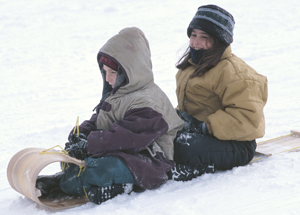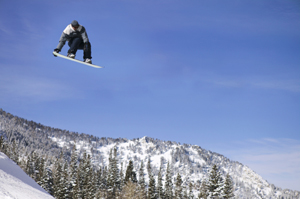Winter Sports Injury Prevention

By following the tips in this article, children and adults can help prevent winter sports injuries
People spend hours of recreation time on activities ranging from sledding, snow skiing and tobogganing to ice hockey, ice skating and snow boarding. According to the American Academy of Orthopaedic Surgeons (AAOS), however, if the proper precautions are not taken to ensure warmth and safety, severe injuries can occur.
Winter sports injuries get a lot of attention at hospital emergency rooms, doctors’ offices and clinics. Injuries include sprains and strains, dislocations and fractures. In 2007, the U.S. Consumer Product Safety Commission reported:
- 139,332 injuries from snow skiing
- 164,002 injuries from snow boarding
- 133,551 injuries from ice skating
- 53,273 injuries from ice hockey
- 160,020 injuries from sledding, snow tubing, and tobogganing
- 34,562 injuries from snowmobiling
Many winter sports injuries happen at the end of the day, when people overexert themselves to finish that one last run before the day’s end. A majority of these injuries can easily be prevented if participants prepare for their sport by keeping in good physical condition, staying alert and stopping when they are tired or in pain.
The AAOS urges children and adults to follow these tips for preventing winter sports injuries:
- Never participate alone in a winter sport.
- Keep in shape and condition muscles before participating in winter activities.
- Warm up thoroughly before playing. Cold muscles, tendons and ligaments are vulnerable to injury.
- Wear appropriate protective gear, including goggles, helmets, gloves and padding.
- Check that equipment is in good working order and used properly.
- Wear several layers of light, loose and water- and wind-resistant clothing for warmth and protection. Layering allows you to accommodate your body’s constantly changing temperature. Wear proper footwear that provides warmth and dryness, as well as ample ankle support.
- Know and abide by all rules of the sport in which you are participating.
- Take a lesson (or several) from a qualified instructor, especially in sports like skiing and snow boarding. Learning how to fall correctly and safely can reduce the risk of injury.
- Pay attention to warnings about upcoming storms and severe drops in temperature to ensure safety.
- Seek shelter and medical attention immediately if you, or anyone with you, is experiencing hypothermia or frostbite. Make sure everyone is aware of proper procedures for getting help, if injuries occur.
- Drink plenty of water before, during, and after activities. Dehydration is still a risk, even in cold weather. Alcohol increases the risk of dehydration, decreases your ability to perform sport specific tasks (even though you might THINK you are skiing better), and actually makes you more prone to hypothermia as it shunts blood away from your core and out to the skin, where you suffer heat loss even faster, although you FEEL warm due to the flushing effects of the alcohol. Overall, alcohol and cold weather add up to serious risk of injury.

Many winter sports injuries happen at the end of the day, when people overexert themselves to finish that one last run before the day's end.
Skiing and Snowboarding
Children and adolescents are the highest risk groups for injury when skiing and snowboarding. This may be related to the risk-taking behavior common in these age groups, especially the desire for “air” and taking jumps. The most common injuries are wrist fractures (snowboarding), knee injuries (skiing), and head injuries (both). Head injuries are often the result falls or collisions (skier-tree, and skier-skier) and collisions are the leading cause of death. In one study, of those children who suffered head, neck, and face injuries, 70% were not wearing a helmet. The use of ski helmets results in up to a 60% decrease in risk of head injury.
Wrist guards can decrease the risk of hand, wrist and forearm injuries by 85% in those who snowboard, yet only 5% of snowboarders wear these devices.
.
What is the take-home message? Require your child to wear protective equipment (especially a helmet) when skiing or snowboarding!
Sledding
Sledding can be problematic because it usually does not occur in a controlled environment. Whereas skiing and snowboarding are primarily enjoyed at ski resorts, sledding can occur anywhere there is a hill. Thus, unlike the groomed slopes of a ski hill, obstacles in the path of the sled may not have been removed. Injuries from sledding again usually occur from collisions with fixed objects, and most occur with sleds that do not have steering capabilities. Sledding is the most common activity associated with admission to a hospital in children under 16 years of age.
How can you minimize the risk? Supervise your child. Be sure to inspect the hill where your children will be sledding. Try to use a sled with some steering capability. Remove any object that could pose a risk (keep in mind that some may be hidden under the snow), and require your child to wear protective equipment. While there are no studies specifically looking at helmets in those who are sledding, and there are no helmets specifically designed for the sport, using a helmet makes sense. Be sure the hill is not too steep so they do not reach high speeds, and a hill that leads onto a street where there is vehicular traffic can have disastrous results. Finally, never sled head first.
Innertubing should also be considered here. Innertubes may have valves that stick out and can impale the rider. In addition, a hard landing on the snow or ice can result in spine and neck injuries. Inspect the tube to be sure there is no valve that could pose a risk, choose a hill that is not too high (to keep the speed down) and doesn’t have any bumps or “jumps” to prevent hard landings. Most importantly, supervise your children.
Go out and enjoy the winter sports activities, but paying attention to the above information can significantly improve your chances of having a fun, safe, and enjoyable sinter sports experience. Remember also, that in case of injury, we at Shasta Orthopaedics and Sports Medicine are here to help.
Article by Paul Schwartz, MD
